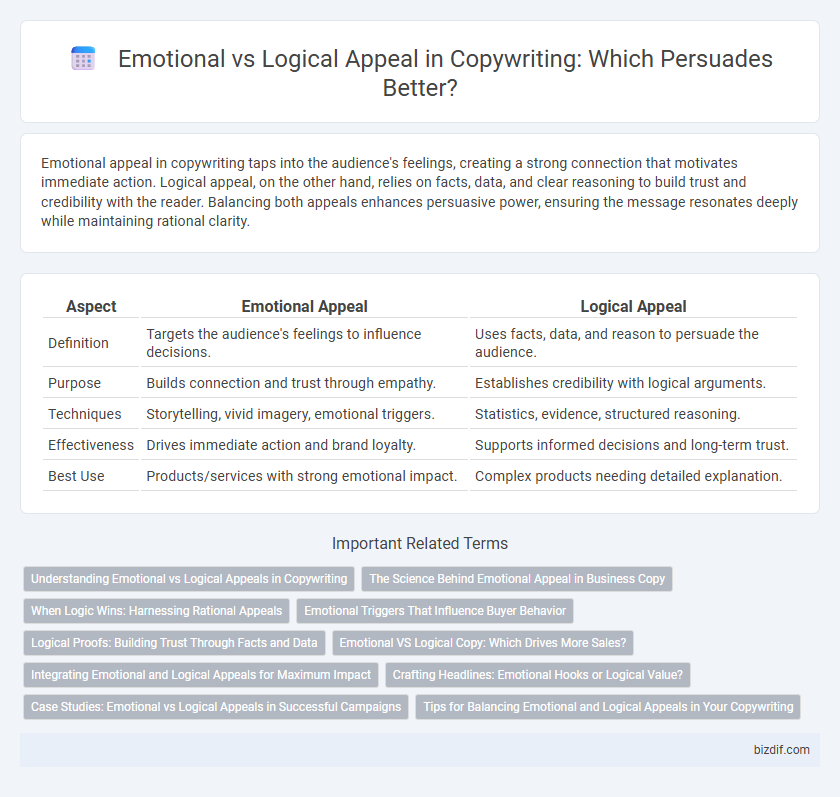Emotional appeal in copywriting taps into the audience's feelings, creating a strong connection that motivates immediate action. Logical appeal, on the other hand, relies on facts, data, and clear reasoning to build trust and credibility with the reader. Balancing both appeals enhances persuasive power, ensuring the message resonates deeply while maintaining rational clarity.
Table of Comparison
| Aspect | Emotional Appeal | Logical Appeal |
|---|---|---|
| Definition | Targets the audience's feelings to influence decisions. | Uses facts, data, and reason to persuade the audience. |
| Purpose | Builds connection and trust through empathy. | Establishes credibility with logical arguments. |
| Techniques | Storytelling, vivid imagery, emotional triggers. | Statistics, evidence, structured reasoning. |
| Effectiveness | Drives immediate action and brand loyalty. | Supports informed decisions and long-term trust. |
| Best Use | Products/services with strong emotional impact. | Complex products needing detailed explanation. |
Understanding Emotional vs Logical Appeals in Copywriting
Emotional appeal in copywriting triggers feelings such as happiness, fear, or empathy to create a strong connection with the audience, often driving immediate actions. Logical appeal relies on data, facts, and rational arguments to persuade consumers through clear reasoning and evidence. Understanding the balance between emotional and logical appeals enables marketers to craft compelling messages that resonate deeply while providing credible information to support purchasing decisions.
The Science Behind Emotional Appeal in Business Copy
Emotional appeal in business copy triggers the brain's limbic system, which governs feelings and decision-making, making ads more memorable and persuasive. Studies show consumers rely on emotions rather than logic, with 95% of purchase decisions driven by subconscious feelings. Effective emotional copy harnesses storytelling, vivid imagery, and sensory language to create a strong psychological connection that motivates action.
When Logic Wins: Harnessing Rational Appeals
Logical appeals in copywriting leverage data, facts, and clear reasoning to persuade audiences seeking practical solutions. Emphasizing statistics, product benefits, and cost-effectiveness builds credibility and appeals to consumers' rational decision-making processes. This approach is especially effective in B2B marketing, technical products, and high-involvement purchases where trust and informed choices drive conversions.
Emotional Triggers That Influence Buyer Behavior
Emotional triggers such as fear, happiness, and trust significantly influence buyer behavior by creating a strong psychological connection to a product or brand, which often leads to higher engagement and conversion rates. Logical appeals rely on facts and data to convince buyers through rational decision-making, but emotional triggers tap into subconscious desires and motivations that drive impulsive purchases. Understanding and leveraging emotional appeal in copywriting enhances persuasive power by resonating deeply with the audience's personal values and experiences.
Logical Proofs: Building Trust Through Facts and Data
Logical proofs in copywriting build trust by presenting clear facts, statistics, and data that support claims, creating credibility with audiences. Emphasizing evidence-based information helps potential customers make informed decisions, reducing skepticism and enhancing the perceived reliability of the product or service. Brands using logical appeal effectively combine data-driven arguments with transparent communication, leading to higher conversion rates and sustained customer loyalty.
Emotional VS Logical Copy: Which Drives More Sales?
Emotional copywriting leverages feelings like trust, fear, and desire to create strong connections that motivate immediate action, often resulting in higher engagement and conversion rates. Logical appeal uses facts, statistics, and reasoned arguments to persuade through credibility and clear value, appealing to analytic buyers who prioritize evidence and practicality. Studies show a strategic blend of emotional and logical elements can optimize sales by addressing both the heart and mind of consumers.
Integrating Emotional and Logical Appeals for Maximum Impact
Integrating emotional and logical appeals in copywriting enhances message effectiveness by engaging both the heart and mind of the audience. Emotional appeal triggers feelings such as trust, fear, or happiness, while logical appeal provides facts, statistics, and rational arguments to support purchasing decisions. Combining these strategies creates a balanced narrative that motivates action through empathy and reason, maximizing conversion rates and brand loyalty.
Crafting Headlines: Emotional Hooks or Logical Value?
Crafting headlines with emotional hooks leverages psychological triggers like curiosity, fear, or joy to instantly capture attention and create a compelling connection with readers. Logical value in headlines emphasizes clear benefits, facts, and problem-solving to appeal to rational decision-making and build trust. Combining emotional appeal and logical value strategically enhances engagement and click-through rates by addressing both the heart and mind of the audience.
Case Studies: Emotional vs Logical Appeals in Successful Campaigns
Case studies reveal that campaigns employing emotional appeal, such as Nike's "Just Do It," generate stronger brand loyalty by evoking motivation and personal connection, resulting in a 31% sales increase. In contrast, logical appeal campaigns like IBM's B2B "Smarter Planet" utilize data-driven arguments and product benefits, boosting client acquisition rates by 22%. Effective copywriting strategically blends emotional storytelling with factual evidence to maximize audience engagement and conversion rates.
Tips for Balancing Emotional and Logical Appeals in Your Copywriting
Effective copywriting balances emotional appeal and logical appeal by crafting messages that resonate on a personal level while providing clear, rational benefits. Use storytelling and vivid imagery to engage emotions, paired with factual data, testimonials, and specific benefits to satisfy logical reasoning. Testing different combinations and analyzing audience response helps refine the balance for maximum impact and conversion.
Emotional Appeal vs Logical Appeal Infographic

 bizdif.com
bizdif.com